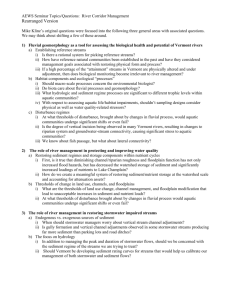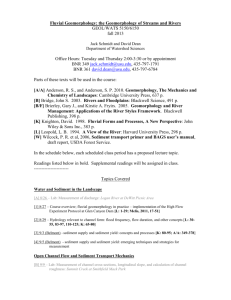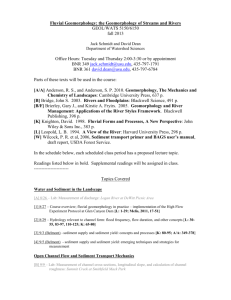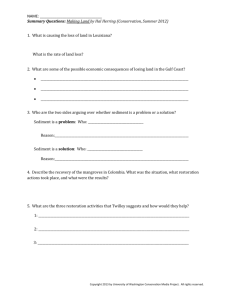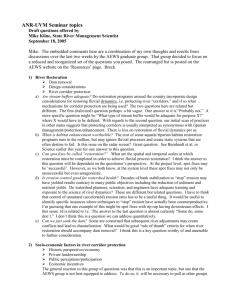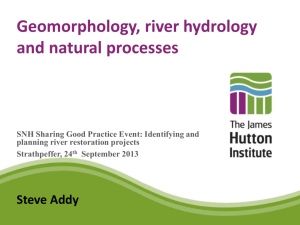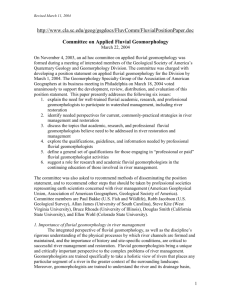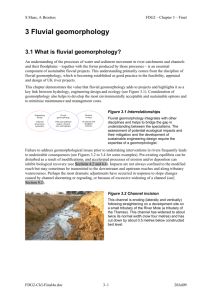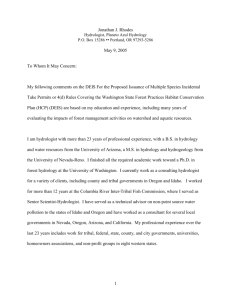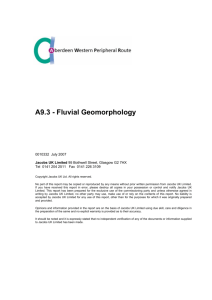INFO
advertisement
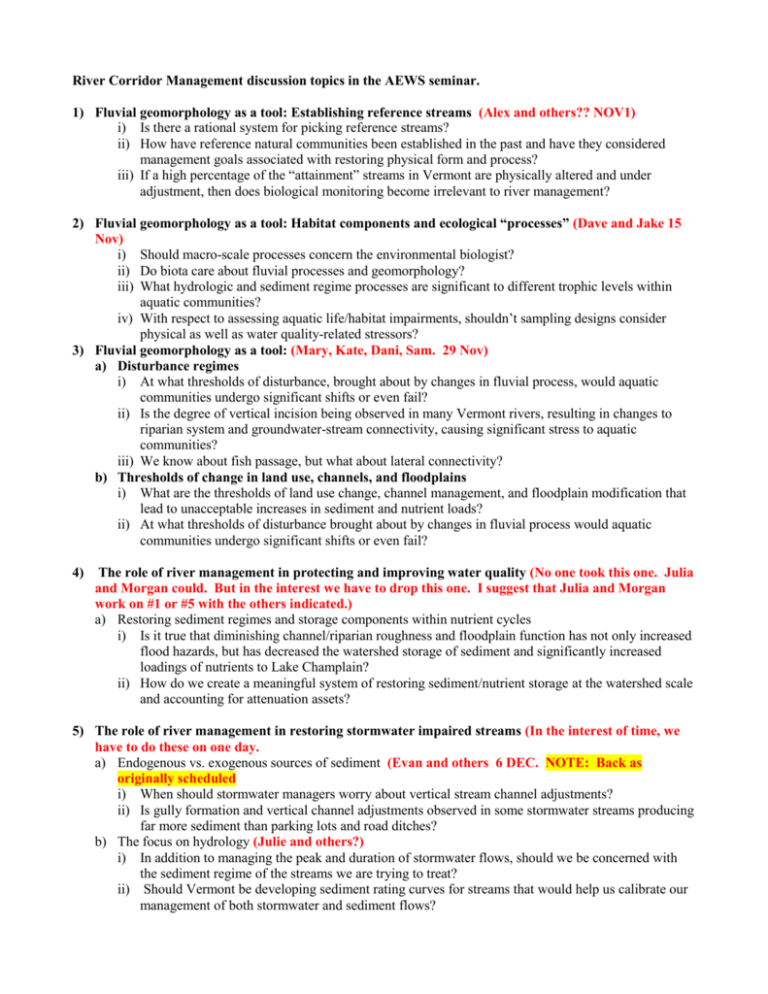
River Corridor Management discussion topics in the AEWS seminar. 1) Fluvial geomorphology as a tool: Establishing reference streams (Alex and others?? NOV1) i) Is there a rational system for picking reference streams? ii) How have reference natural communities been established in the past and have they considered management goals associated with restoring physical form and process? iii) If a high percentage of the “attainment” streams in Vermont are physically altered and under adjustment, then does biological monitoring become irrelevant to river management? 2) Fluvial geomorphology as a tool: Habitat components and ecological “processes” (Dave and Jake 15 Nov) i) Should macro-scale processes concern the environmental biologist? ii) Do biota care about fluvial processes and geomorphology? iii) What hydrologic and sediment regime processes are significant to different trophic levels within aquatic communities? iv) With respect to assessing aquatic life/habitat impairments, shouldn’t sampling designs consider physical as well as water quality-related stressors? 3) Fluvial geomorphology as a tool: (Mary, Kate, Dani, Sam. 29 Nov) a) Disturbance regimes i) At what thresholds of disturbance, brought about by changes in fluvial process, would aquatic communities undergo significant shifts or even fail? ii) Is the degree of vertical incision being observed in many Vermont rivers, resulting in changes to riparian system and groundwater-stream connectivity, causing significant stress to aquatic communities? iii) We know about fish passage, but what about lateral connectivity? b) Thresholds of change in land use, channels, and floodplains i) What are the thresholds of land use change, channel management, and floodplain modification that lead to unacceptable increases in sediment and nutrient loads? ii) At what thresholds of disturbance brought about by changes in fluvial process would aquatic communities undergo significant shifts or even fail? 4) The role of river management in protecting and improving water quality (No one took this one. Julia and Morgan could. But in the interest we have to drop this one. I suggest that Julia and Morgan work on #1 or #5 with the others indicated.) a) Restoring sediment regimes and storage components within nutrient cycles i) Is it true that diminishing channel/riparian roughness and floodplain function has not only increased flood hazards, but has decreased the watershed storage of sediment and significantly increased loadings of nutrients to Lake Champlain? ii) How do we create a meaningful system of restoring sediment/nutrient storage at the watershed scale and accounting for attenuation assets? 5) The role of river management in restoring stormwater impaired streams (In the interest of time, we have to do these on one day. a) Endogenous vs. exogenous sources of sediment (Evan and others 6 DEC. NOTE: Back as originally scheduled i) When should stormwater managers worry about vertical stream channel adjustments? ii) Is gully formation and vertical channel adjustments observed in some stormwater streams producing far more sediment than parking lots and road ditches? b) The focus on hydrology (Julie and others?) i) In addition to managing the peak and duration of stormwater flows, should we be concerned with the sediment regime of the streams we are trying to treat? ii) Should Vermont be developing sediment rating curves for streams that would help us calibrate our management of both stormwater and sediment flows? Remaining meeting dates and suggested assignments referenced to previous page: 25 AEWS 385 Discussion on BioScience paper: How much is enough? (To be posted) 1 NOVEMBER RCM Topic 1 (Alex and others?) 8 NOVEMBER Graduate student proposal presentation: Evan Fitzgerald 15 NOVEMBER RCM Topic #2: Dave and Jake 22 NOVEMBER Graduate student proposal presentation: Matt Bruhns 29 NOVEMBER RCM Topic #3: Mary, Kate, Dani, and Sam 6 DECEMBER RCM Topic #4: Evan, Julie and others? Suggested approach for the discussions Objectives 1. To lead a productive discussion on the topic 2. To develop a bibliography of recent (last 5 years) literature on the topic. Suggested approach 1. Use ISI Web of Science or other search engine to query literature on the topic over the last 5 years. If insufficient, go back 5 years more. 2. Generate an annotated bibliography of key (not all) reference found. This can be done very easily by printing (or downloading) the abstracts for ‘hits’ found in the ISI search. 3. Select 1-2 articles for the group to read. Provide this article (ideally as a PDF) ONE WEEK PRIOR to the scheduled discussion. 4. On the scheduled day, lead a discussion. This might include providing several (2-6?) thoughtful questions about the papers for ucs to consider. No need to prepare a Powerpoint intro. Rather, we should all be ready to engage in productive discussion. 5. As soon as possible, but no later than the scheduled discussion date, provide a copy of the annotated key bibliography.
